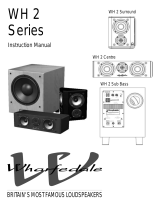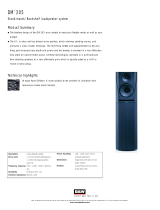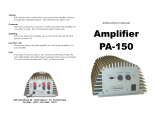Positioning the Front Loudspeakers (...cont. from page 4)
magnetically shielded so they may be positioned close to TV screens
and monitors with no ill-effects or colour distortion.
D9 DFS Surround Loudspeakers
Centre Loudspeaker
The Centre channel loudspeaker should be positioned centrally between
the loudspeakers, close to the television and mounted above or below
the screen.
The loudspeaker should be located on
a stable flat surface to avoid any
cabinet movement at high sound
levels. If you mount the unit on top of
the television, move it forward so that
the front grille sits slightly in front of
the screen. This will reduce sound
D9 SR Surround Loudspeakers
reflections from the screen and the top
Before mounting the loudspeakers, establish the
of the cabinet.
location using the same criteria as for the D9 DFS.
The D9 CS and the D9 CM are supplied
Ensure the wall is sound and can easily support the
fitted with mounting feet which
weight of the loudspeakers.
support the cabinet in a horizontal
The D9 SR is supplied with four mounting feet for shelf
position. Four extra feet are supplied to
or stand mounting. In addition the terminal panel has a
enable you to tilt the cabinet up or
built in mounting slot for wall fixing.
down so that the speaker points
directly at the listening position. This
Wall mounting the D9 SR: Ensure the wall is sound
facility is particularly useful where the
and can easily support the weight of the loudspeakers.
Centre speaker is mounted under the
Drill and fix a No. 8 screw and suitable wall plug at each chosen location.
screen.
The screw should protrude about 5mm from the wall. Connect the cable
to the speaker. Align the keyhole slot over the screw. Pull gently down to
NOTE: All Diamond 9 bookshelf and floorstanding loudspeakers are
secure the speaker.
The speakers should ideally be sited 600 mm-1.5 metres above the
listening position and 2.5-3.5 metres apart, central to the listener and
behind the listening position,
preferably on a rear wall.
Ensure that the wall is sound and can
support the product. Drill two 5mm
holes in the wall 220mm apart. Fix a
suitable No 8 round head screw firmly
into each hole using appropriate wall
plugs. Leave a stub of 5mm protruding
from the wall.
Connect the loudspeakers. Align the
holes in the mounting brackets over
the screw and carefully lower the unit
onto the screws. The speaker should
now be securely attached with the
spacers resting against the wall. Now connect the
speakers to the amplifier.
Note: As an alternative, the D9 DFS can be shelf or
stand mounted. The badge on the D9 DFS can be
rotated to match the orientation of the loudspeaker.
If the
listening position is some distance
from a rear wall, the speakers may be
mounted on opposite side walls but
always behind the listening position.
2 - 4 metres
º
0
4
-
5
1
>0.7metre
9.0 - 9.3
>200 mm
9.4 - 9.6
>50 mm
DVD/ PROCESSOR
RACK
TV
X2
The diagrams below illustrate some typical Home Cinema room layouts.
System with Rear Mounted D9 DFS Surrounds
REAR
RIGHT
REAR
LEFT
FRONT
LEFT
FRONT
RIGHT
CENTRE
SUB
WOOFER
System with Side Mounted D9 DFS Surrounds
REAR
RIGHT
REAR
LEFT
FRONT
LEFT
FRONT
RIGHT
CENTRE
SUB
WOOFER
System with D9 SR Surround Speakers
ALTERNATIVE
POSITIONS
FRONT
LEFT
FRONT
RIGHT
CENTRE
SUB
WOOFER
ALTERNATIVE
POSITIONS
THE HOME CINEMA ENVIRONMENT
220 mm
Page 12
Page 5
Volume: Press the Volume + key to increase the volume level. Press the
OPERATING YOUR SUBWOOFER
Volume - key to decrease the volume level of the subwoofer. The volume
Remote Handset
range on the front panel display varies from 00 (minimum) to 99
All control functions are carried out using the remote handset.
(maximum).
Installing batteries
Low Pass Filters: Pressing the appropriate filter key will select the
frequency at which the subwoofer rolls off. The filter has steps at Off and
The handset operates on two LR6 (AA)
35Hz-85Hz in 10 Hz increments. When ‘OFF’ is selected the subwoofer
batteries which are supplied The battery
operates over its full designed range. Pressing other keys lowers the
compartment is located at the rear of the
maximum operating frequency. The Low Pass Filter value should be
handset. Unwrap the batteries and slide the
chosen having regard to the nature of the Front speakers and
cover off the handset. Place the batteries in
programme material. Follow the Setup Notes on Page 6 and the
the handset, the correct orientation is shown
instruction manual of your AV processor (if used) for more guidance.
on the diagram. When the batteries are
installed, replace the cover.
Phase: This key toggles the subwoofer between 0º and 180º phase shift.
Presets: Four different settings of level, frequency and phase can be
stored. Pressing and holding any of the preset keys on the remote for 3
seconds will cause the current settings to be stored in that preset. The
display will show the preset number then flash the preset number once
to show it has stored the preset.
To change from one preset to another, press a preset key on the remote
for less than 3 seconds to recall the settings of that preset. The display
will show the preset number:
If you select a preset and then alter any aspect of the setup, the preset
light will extinguish (as the setup no longer matches the preset).
Switching on the Subwoofer
Note: When brought out of standby for the first time, the unit will display
Check that all the connections to the
the factory presets. Thereafter, bringing the unit out of standby will
subwoofer have been properly made and
revert it to the operational state last used. If you switch the power on and
that the system volume control is at
off at the rear panel while the unit is in standby, the unit will power up to a
minimum. Plug the supplied power cord into
normal operating state (i.e. not in standby). To enter standby, again
the mains socket on the rear panel. Plug the
press the Standby key.
mains plug into the wall socket and switch
the power on. Now switch the subwoofer on
SETTING UP YOUR SUBWOOFER
with the rest of your system. The subwoofer
General Notes
on/off switch has a rocker action; press the
Your subwoofer is most likely to be used with two typical programme
upper part to switch the equipment on and
sources, music and movies. The setup for these two very different
the lower part to switch it off. When switched
sources may be different if best results are to be achieved. Please read
on the light above the power switch will glow
these setup notes in conjunction with your processor and speaker
and the subwoofer will be operational.
manuals.
Operation - Controls and Functions
All setting up of the subwoofer should be performed with tone controls
and filters set ‘flat’.
Control functions are carried out using the remote handset. To operate,
Listening Rooms and Subwoofer Positioning:
the handset must be point at the subwoofer and be in direct line of sight.
Listening rooms are not ideal. Most rooms are reverberant with some
Standby: The Standby key brings the subwoofer in and out of Standby.
parallel walls. Because of room geometry and construction there will be
The drawing below shows a typical front panel display during operation.
areas with severe peaks at some frequencies and severe troughs at
others. These peaks and troughs are called ‘standing waves’ and if you
site loudspeakers in such areas the response will be highly non-linear.
With subwoofers this situation is exacerbated by the fact that it is easier
to treat high frequency irregularities by the use of drapes, soft
furnishings etc., but very hard to do the same at bass frequencies due to
the very long wavelengths - at 40 Hz the wavelength is almost 9 metres!
To help locate standing waves in your listening room, one idea is to sit in
the listening seat and recruit a friend with a deep voice to speak as he
moves around the area where you propose to site your subwoofer - you
will soon find out where not to site it! Where the voice sounds most
natural is a good place to start.
The low frequency response of the subwoofer and its blend with the main
loudspeakers is greatly affected by positioning. Although bass is
The preset light will not light if no preset has been set up or if a preset
enhanced by walls or corners, so often is coloration. As the drive unit
has been over-ridden.
faces downward, the floor will influence the sound. The surface under
In Standby mode all the lights on the subwoofer front panel are
the subwoofer should be stable and unobstructed. If the carpet is thick,
extinguished. The rear panel light remains on to show the unit is
consider placing the subwoofer on a solid surface such as a marble slab.
powered.
SUBWOOFER CONTROL
AA AA
OFF
LOW PA SS FILTER S ELECT
85Hz75Hz65Hz55Hz
45Hz
35Hz
MEM ORY
POW ER
PHA SE
0
18 0
1 2
3
4
VOL UME
SW-250














